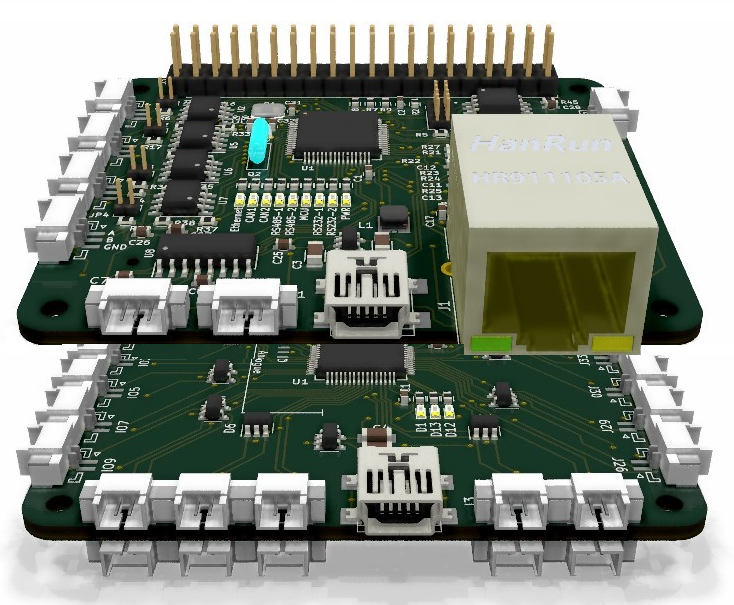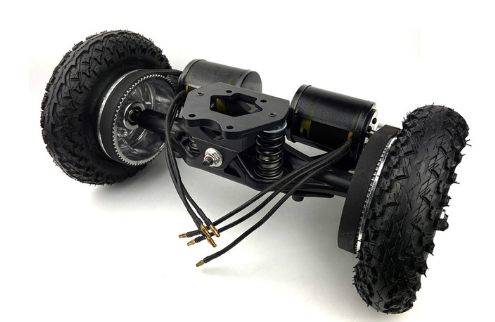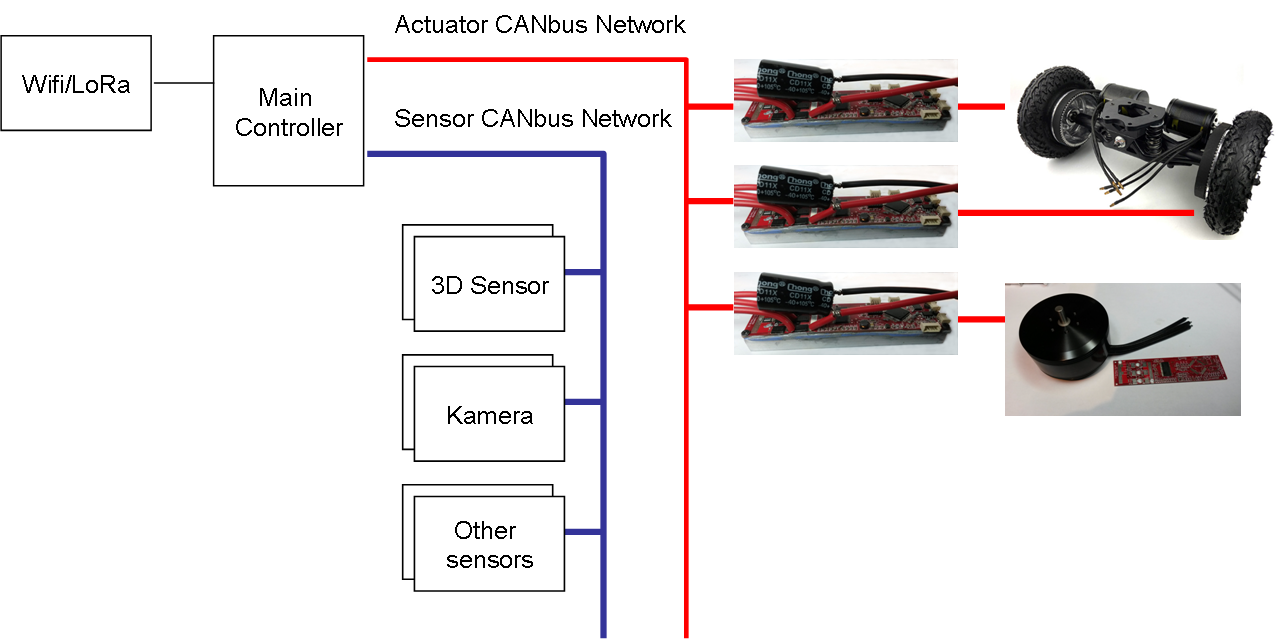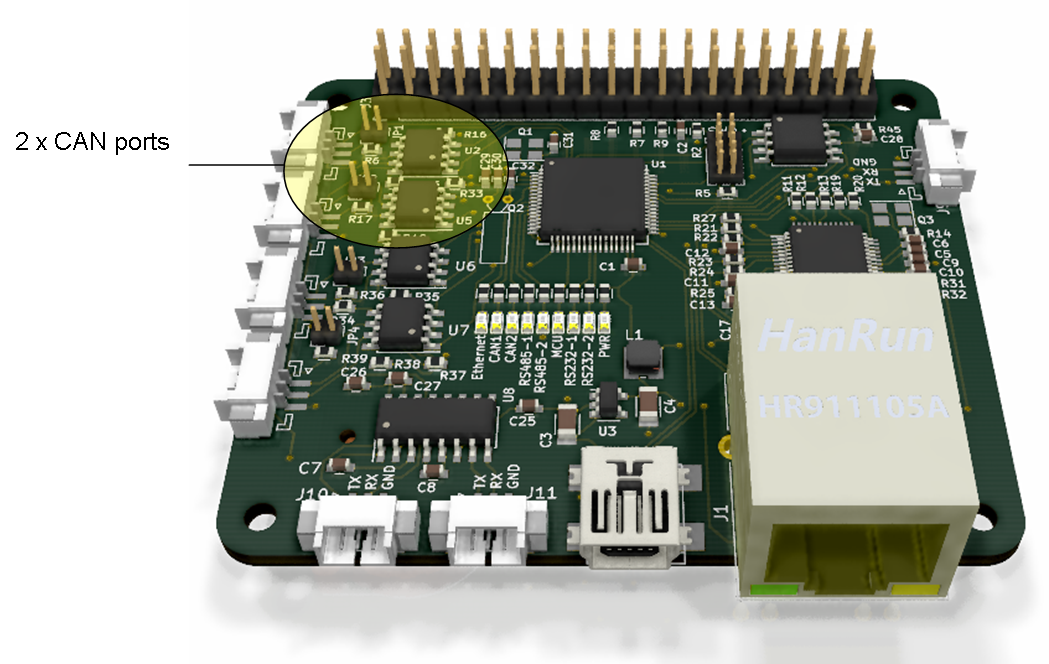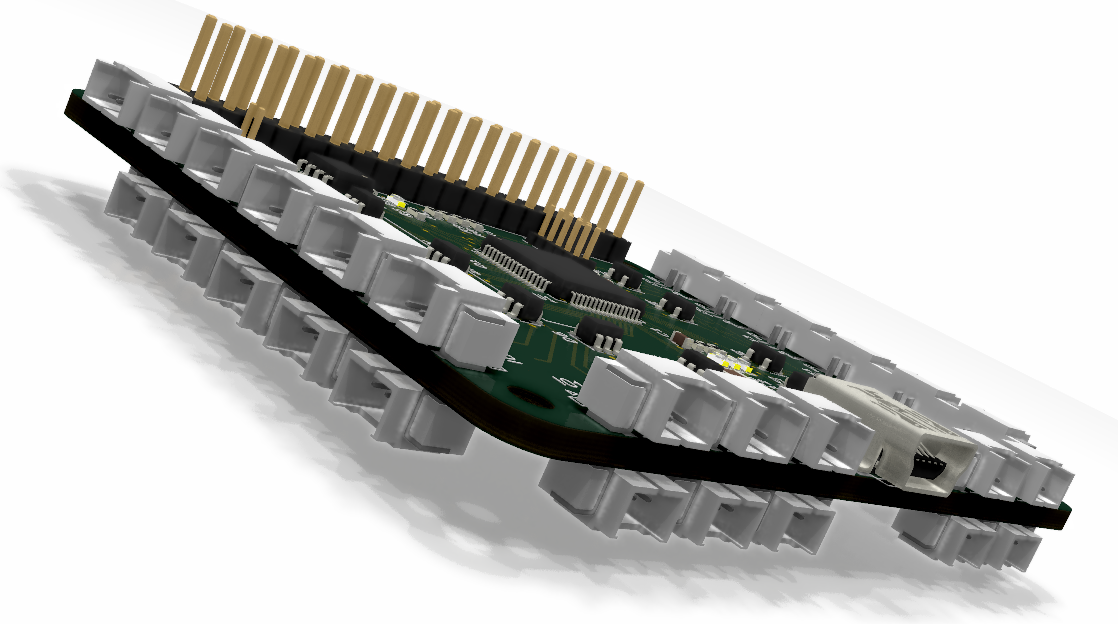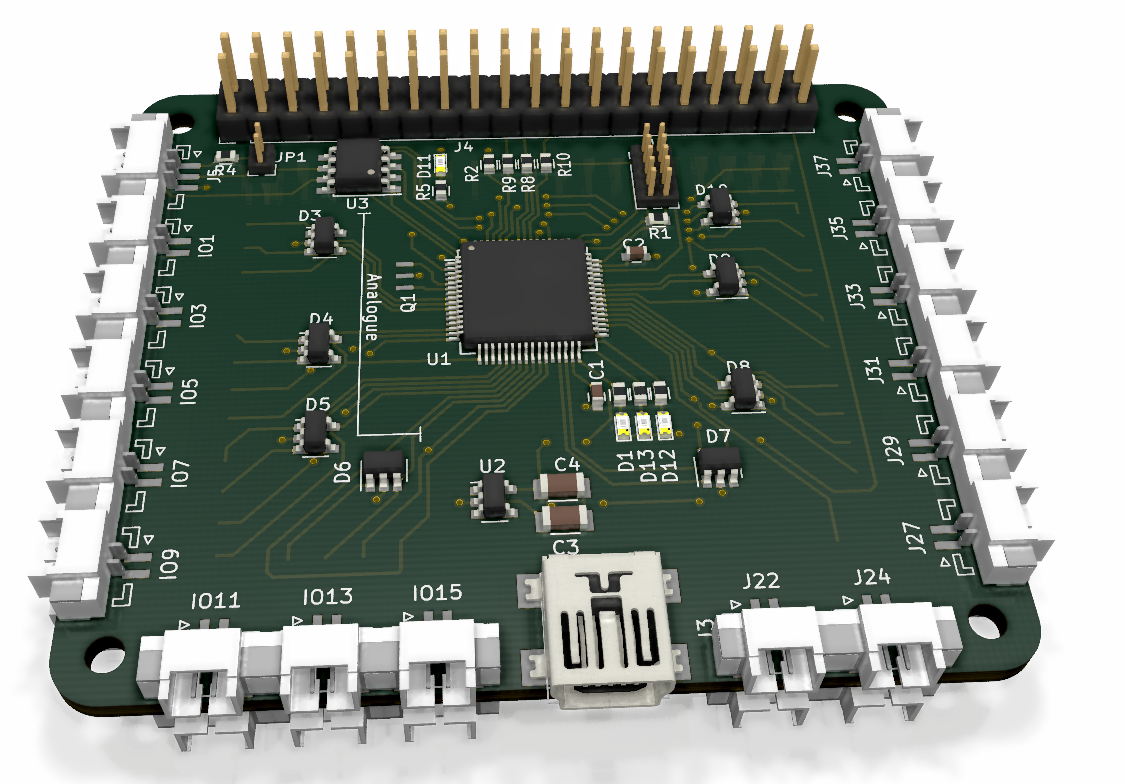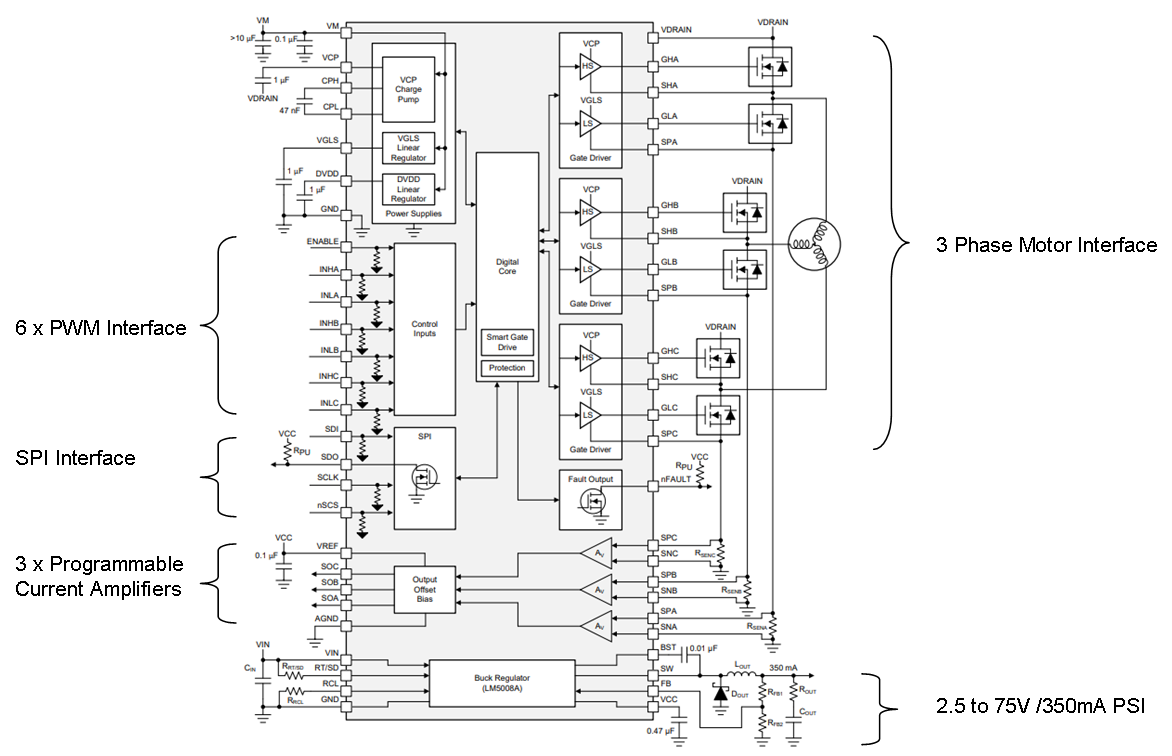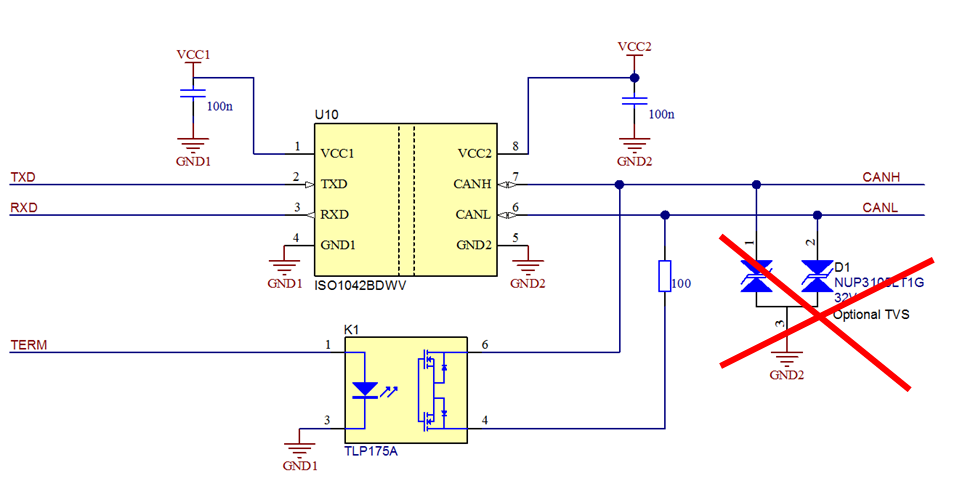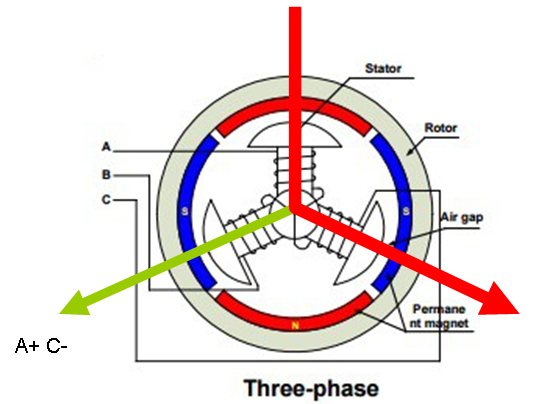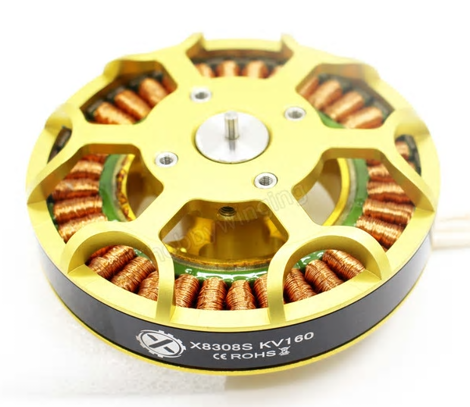As mentioned in part2 I want to create a 360 degree vector table with PWM duties for A,B and C. This allows me to drive sinusoidal by simply stepping 0 to 359. To do this I create a small C application as follows:
#include "stdio.h"
#include "stdlib.h"
#include "math.h"
int main(int argc, char* argv)
{
FILE* fd = fopen("vectors.cpp", "w");
if (fd != NULL)
{
fprintf(fd, "alSinusVector _vector[AL3P_VECTOR_SIZE]=\n");
fprintf(fd, "{\n");
for (int i = 0; i < 360; i++)
{
double vA, vB, vC;
vA = sin(i*3.14/180.0);
vB = sin((i + 120)*3.14/180.0);
vC = sin((i + 120 + 120)*3.14/180.0);
fprintf(fd, " %f, %f, %f, // %d\n",vA,vB,vC, i);
}
fprintf(fd, "};\n");
fclose(fd);
}
}
The math is vA = sin (radians(degrees)), while vB is +120 degrees etc. This will generate a table with values -1 to +1. I use the – kow if I should swith on High or Low MOSFET and the value to compute a duty. The only thing I need to do is actually to multiply with torque + I control speed with how fast I step this. The generated table is below – I have to test this, but looking at the values I think it should work. Note that I generate all 3 vectors here, but you can actually manage with only one since B is A+120 etc.
alSinusVector al3PhaseMotor::m_vector[AL3P_VECTOR_SIZE]=
{
0.000000, 0.866556, -0.864962, // 0
0.017444, 0.857718, -0.873584, // 1
0.034882, 0.848620, -0.881940, // 2
0.052309, 0.839263, -0.890028, // 3
0.069721, 0.829651, -0.897846, // 4
0.087112, 0.819786, -0.905390, // 5
0.104476, 0.809672, -0.912658, // 6
0.121808, 0.799311, -0.919649, // 7
0.139103, 0.788708, -0.926360, // 8
0.156356, 0.777864, -0.932789, // 9
0.173561, 0.766783, -0.938934, // 10
0.190713, 0.755470, -0.944793, // 11
0.207808, 0.743926, -0.950365, // 12
0.224839, 0.732156, -0.955648, // 13
0.241802, 0.720163, -0.960640, // 14
0.258691, 0.707951, -0.965339, // 15
0.275501, 0.695523, -0.969745, // 16
0.292228, 0.682884, -0.973856, // 17
0.308866, 0.670038, -0.977670, // 18
0.325409, 0.656987, -0.981187, // 19
0.341854, 0.643736, -0.984406, // 20
0.358194, 0.630289, -0.987324, // 21
0.374426, 0.616651, -0.989943, // 22
0.390544, 0.602825, -0.992260, // 23
0.406543, 0.588816, -0.994275, // 24
0.422418, 0.574627, -0.995988, // 25
0.438164, 0.560263, -0.997397, // 26
0.453778, 0.545729, -0.998503, // 27
0.469253, 0.531029, -0.999305, // 28
0.484585, 0.516168, -0.999803, // 29
0.499770, 0.501149, -0.999997, // 30
0.514803, 0.485978, -0.999887, // 31
0.529679, 0.470659, -0.999472, // 32
0.544394, 0.455196, -0.998753, // 33
0.558943, 0.439595, -0.997730, // 34
0.573323, 0.423861, -0.996404, // 35
0.587528, 0.407997, -0.994774, // 36
0.601554, 0.392009, -0.992842, // 37
0.615396, 0.375902, -0.990607, // 38
0.629052, 0.359681, -0.988072, // 39
0.642516, 0.343350, -0.985235, // 40
0.655785, 0.326915, -0.982099, // 41
0.668854, 0.310380, -0.978663, // 42
0.681720, 0.293751, -0.974930, // 43
0.694378, 0.277032, -0.970901, // 44
0.706825, 0.260229, -0.966575, // 45
0.719057, 0.243347, -0.961956, // 46
0.731070, 0.226391, -0.957044, // 47
0.742861, 0.209365, -0.951841, // 48
0.754425, 0.192277, -0.946348, // 49
0.765760, 0.175129, -0.940567, // 50
0.776862, 0.157929, -0.934500, // 51
0.787727, 0.140680, -0.928149, // 52
0.798353, 0.123389, -0.921515, // 53
0.808736, 0.106059, -0.914600, // 54
0.818873, 0.088698, -0.907408, // 55
0.828760, 0.071310, -0.899939, // 56
0.838396, 0.053900, -0.892196, // 57
0.847776, 0.036473, -0.884182, // 58
0.856898, 0.019036, -0.875899, // 59
0.865760, 0.001593, -0.867350, // 60
0.874358, -0.015851, -0.858536, // 61
0.882690, -0.033290, -0.849461, // 62
0.890753, -0.050719, -0.840128, // 63
0.898546, -0.068132, -0.830539, // 64
0.906065, -0.085525, -0.820697, // 65
0.913308, -0.102892, -0.810605, // 66
0.920273, -0.120227, -0.800267, // 67
0.926958, -0.137526, -0.789686, // 68
0.933361, -0.154783, -0.778864, // 69
0.939481, -0.171992, -0.767805, // 70
0.945314, -0.189150, -0.756512, // 71
0.950859, -0.206250, -0.744989, // 72
0.956116, -0.223287, -0.733240, // 73
0.961081, -0.240256, -0.721267, // 74
0.965754, -0.257152, -0.709075, // 75
0.970133, -0.273970, -0.696667, // 76
0.974217, -0.290704, -0.684047, // 77
0.978004, -0.307350, -0.671219, // 78
0.981494, -0.323903, -0.658187, // 79
0.984685, -0.340357, -0.644954, // 80
0.987576, -0.356707, -0.631525, // 81
0.990167, -0.372949, -0.617904, // 82
0.992456, -0.389077, -0.604095, // 83
0.994444, -0.405087, -0.590102, // 84
0.996129, -0.420974, -0.575930, // 85
0.997511, -0.436732, -0.561582, // 86
0.998589, -0.452358, -0.547063, // 87
0.999363, -0.467846, -0.532378, // 88
0.999834, -0.483191, -0.517531, // 89
1.000000, -0.498390, -0.502527, // 90
0.999861, -0.513437, -0.487369, // 91
0.999419, -0.528328, -0.472063, // 92
0.998672, -0.543057, -0.456614, // 93
0.997622, -0.557622, -0.441025, // 94
0.996268, -0.572017, -0.425303, // 95
0.994610, -0.586238, -0.409451, // 96
0.992650, -0.600281, -0.393474, // 97
0.990388, -0.614140, -0.377378, // 98
0.987825, -0.627813, -0.361167, // 99
0.984961, -0.641295, -0.344846, // 100
0.981797, -0.654582, -0.328419, // 101
0.978335, -0.667670, -0.311894, // 102
0.974575, -0.680554, -0.295273, // 103
0.970518, -0.693231, -0.278562, // 104
0.966166, -0.705698, -0.261766, // 105
0.961520, -0.717949, -0.244891, // 106
0.956581, -0.729982, -0.227942, // 107
0.951351, -0.741793, -0.210923, // 108
0.945832, -0.753379, -0.193839, // 109
0.940025, -0.764735, -0.176697, // 110
0.933932, -0.775858, -0.159501, // 111
0.927555, -0.786745, -0.142257, // 112
0.920895, -0.797393, -0.124969, // 113
0.913955, -0.807798, -0.107643, // 114
0.906737, -0.817958, -0.090284, // 115
0.899244, -0.827868, -0.072898, // 116
0.891476, -0.837527, -0.055490, // 117
0.883437, -0.846930, -0.038065, // 118
0.875130, -0.856076, -0.020628, // 119
0.866556, -0.864962, -0.003185, // 120
0.857718, -0.873584, 0.014259, // 121
0.848620, -0.881940, 0.031698, // 122
0.839263, -0.890028, 0.049128, // 123
0.829651, -0.897846, 0.066543, // 124
0.819786, -0.905390, 0.083938, // 125
0.809672, -0.912658, 0.101307, // 126
0.799311, -0.919649, 0.118646, // 127
0.788708, -0.926360, 0.135948, // 128
0.777864, -0.932789, 0.153209, // 129
0.766783, -0.938934, 0.170423, // 130
0.755470, -0.944793, 0.187586, // 131
0.743926, -0.950365, 0.204691, // 132
0.732156, -0.955648, 0.221734, // 133
0.720163, -0.960640, 0.238710, // 134
0.707951, -0.965339, 0.255613, // 135
0.695523, -0.969745, 0.272438, // 136
0.682884, -0.973856, 0.289180, // 137
0.670038, -0.977670, 0.305834, // 138
0.656987, -0.981187, 0.322396, // 139
0.643736, -0.984406, 0.338859, // 140
0.630289, -0.987324, 0.355219, // 141
0.616651, -0.989943, 0.371471, // 142
0.602825, -0.992260, 0.387609, // 143
0.588816, -0.994275, 0.403630, // 144
0.574627, -0.995988, 0.419528, // 145
0.560263, -0.997397, 0.435299, // 146
0.545729, -0.998503, 0.450937, // 147
0.531029, -0.999305, 0.466438, // 148
0.516168, -0.999803, 0.481796, // 149
0.501149, -0.999997, 0.497009, // 150
0.485978, -0.999887, 0.512070, // 151
0.470659, -0.999472, 0.526975, // 152
0.455196, -0.998753, 0.541719, // 153
0.439595, -0.997730, 0.556299, // 154
0.423861, -0.996404, 0.570710, // 155
0.407997, -0.994774, 0.584947, // 156
0.392009, -0.992842, 0.599006, // 157
0.375902, -0.990607, 0.612883, // 158
0.359681, -0.988072, 0.626573, // 159
0.343350, -0.985235, 0.640072, // 160
0.326915, -0.982099, 0.653377, // 161
0.310380, -0.978663, 0.666483, // 162
0.293751, -0.974930, 0.679386, // 163
0.277032, -0.970901, 0.692083, // 164
0.260229, -0.966575, 0.704568, // 165
0.243347, -0.961956, 0.716840, // 166
0.226391, -0.957044, 0.728893, // 167
0.209365, -0.951841, 0.740724, // 168
0.192277, -0.946348, 0.752330, // 169
0.175129, -0.940567, 0.763708, // 170
0.157929, -0.934500, 0.774852, // 171
0.140680, -0.928149, 0.785761, // 172
0.123389, -0.921515, 0.796431, // 173
0.106059, -0.914600, 0.806858, // 174
0.088698, -0.907408, 0.817040, // 175
0.071310, -0.899939, 0.826974, // 176
0.053900, -0.892196, 0.836655, // 177
0.036473, -0.884182, 0.846082, // 178
0.019036, -0.875899, 0.855252, // 179
0.001593, -0.867350, 0.864161, // 180
-0.015851, -0.858536, 0.872808, // 181
-0.033290, -0.849461, 0.881188, // 182
-0.050719, -0.840128, 0.889301, // 183
-0.068132, -0.830539, 0.897143, // 184
-0.085525, -0.820697, 0.904712, // 185
-0.102892, -0.810605, 0.912006, // 186
-0.120227, -0.800267, 0.919022, // 187
-0.137526, -0.789686, 0.925759, // 188
-0.154783, -0.778864, 0.932213, // 189
-0.171992, -0.767805, 0.938385, // 190
-0.189150, -0.756512, 0.944270, // 191
-0.206250, -0.744989, 0.949868, // 192
-0.223287, -0.733240, 0.955178, // 193
-0.240256, -0.721267, 0.960196, // 194
-0.257152, -0.709075, 0.964923, // 195
-0.273970, -0.696667, 0.969355, // 196
-0.290704, -0.684047, 0.973493, // 197
-0.307350, -0.671219, 0.977335, // 198
-0.323903, -0.658187, 0.980879, // 199
-0.340357, -0.644954, 0.984124, // 200
-0.356707, -0.631525, 0.987070, // 201
-0.372949, -0.617904, 0.989716, // 202
-0.389077, -0.604095, 0.992061, // 203
-0.405087, -0.590102, 0.994104, // 204
-0.420974, -0.575930, 0.995844, // 205
-0.436732, -0.561582, 0.997281, // 206
-0.452358, -0.547063, 0.998415, // 207
-0.467846, -0.532378, 0.999245, // 208
-0.483191, -0.517531, 0.999770, // 209
-0.498390, -0.502527, 0.999992, // 210
-0.513437, -0.487369, 0.999909, // 211
-0.528328, -0.472063, 0.999522, // 212
-0.543057, -0.456614, 0.998831, // 213
-0.557622, -0.441025, 0.997836, // 214
-0.572017, -0.425303, 0.996538, // 215
-0.586238, -0.409451, 0.994936, // 216
-0.600281, -0.393474, 0.993031, // 217
-0.614140, -0.377378, 0.990824, // 218
-0.627813, -0.361167, 0.988316, // 219
-0.641295, -0.344846, 0.985506, // 220
-0.654582, -0.328419, 0.982397, // 221
-0.667670, -0.311894, 0.978989, // 222
-0.680554, -0.295273, 0.975283, // 223
-0.693231, -0.278562, 0.971281, // 224
-0.705698, -0.261766, 0.966983, // 225
-0.717949, -0.244891, 0.962390, // 226
-0.729982, -0.227942, 0.957505, // 227
-0.741793, -0.210923, 0.952328, // 228
-0.753379, -0.193839, 0.946861, // 229
-0.764735, -0.176697, 0.941107, // 230
-0.775858, -0.159501, 0.935066, // 231
-0.786745, -0.142257, 0.928740, // 232
-0.797393, -0.124969, 0.922132, // 233
-0.807798, -0.107643, 0.915243, // 234
-0.817958, -0.090284, 0.908076, // 235
-0.827868, -0.072898, 0.900632, // 236
-0.837527, -0.055490, 0.892915, // 237
-0.846930, -0.038065, 0.884925, // 238
-0.856076, -0.020628, 0.876667, // 239
-0.864962, -0.003185, 0.868141, // 240
-0.873584, 0.014259, 0.859351, // 241
-0.881940, 0.031698, 0.850300, // 242
-0.890028, 0.049128, 0.840990, // 243
-0.897846, 0.066543, 0.831425, // 244
-0.905390, 0.083938, 0.821606, // 245
-0.912658, 0.101307, 0.811537, // 246
-0.919649, 0.118646, 0.801221, // 247
-0.926360, 0.135948, 0.790662, // 248
-0.932789, 0.153209, 0.779862, // 249
-0.938934, 0.170423, 0.768824, // 250
-0.944793, 0.187586, 0.757553, // 251
-0.950365, 0.204691, 0.746051, // 252
-0.955648, 0.221734, 0.734322, // 253
-0.960640, 0.238710, 0.722369, // 254
-0.965339, 0.255613, 0.710197, // 255
-0.969745, 0.272438, 0.697809, // 256
-0.973856, 0.289180, 0.685208, // 257
-0.977670, 0.305834, 0.672399, // 258
-0.981187, 0.322396, 0.659385, // 259
-0.984406, 0.338859, 0.646170, // 260
-0.987324, 0.355219, 0.632759, // 261
-0.989943, 0.371471, 0.619156, // 262
-0.992260, 0.387609, 0.605363, // 263
-0.994275, 0.403630, 0.591387, // 264
-0.995988, 0.419528, 0.577231, // 265
-0.997397, 0.435299, 0.562899, // 266
-0.998503, 0.450937, 0.548396, // 267
-0.999305, 0.466438, 0.533726, // 268
-0.999803, 0.481796, 0.518893, // 269
-0.999997, 0.497009, 0.503903, // 270
-0.999887, 0.512070, 0.488759, // 271
-0.999472, 0.526975, 0.473467, // 272
-0.998753, 0.541719, 0.458030, // 273
-0.997730, 0.556299, 0.442454, // 274
-0.996404, 0.570710, 0.426744, // 275
-0.994774, 0.584947, 0.410903, // 276
-0.992842, 0.599006, 0.394938, // 277
-0.990607, 0.612883, 0.378852, // 278
-0.988072, 0.626573, 0.362651, // 279
-0.985235, 0.640072, 0.346340, // 280
-0.982099, 0.653377, 0.329923, // 281
-0.978663, 0.666483, 0.313406, // 282
-0.974930, 0.679386, 0.296794, // 283
-0.970901, 0.692083, 0.280091, // 284
-0.966575, 0.704568, 0.263303, // 285
-0.961956, 0.716840, 0.246435, // 286
-0.957044, 0.728893, 0.229492, // 287
-0.951841, 0.740724, 0.212479, // 288
-0.946348, 0.752330, 0.195402, // 289
-0.940567, 0.763708, 0.178264, // 290
-0.934500, 0.774852, 0.161073, // 291
-0.928149, 0.785761, 0.143833, // 292
-0.921515, 0.796431, 0.126549, // 293
-0.914600, 0.806858, 0.109226, // 294
-0.907408, 0.817040, 0.091870, // 295
-0.899939, 0.826974, 0.074487, // 296
-0.892196, 0.836655, 0.057080, // 297
-0.884182, 0.846082, 0.039656, // 298
-0.875899, 0.855252, 0.022221, // 299
-0.867350, 0.864161, 0.004778, // 300
-0.858536, 0.872808, -0.012666, // 301
-0.849461, 0.881188, -0.030106, // 302
-0.840128, 0.889301, -0.047537, // 303
-0.830539, 0.897143, -0.064954, // 304
-0.820697, 0.904712, -0.082351, // 305
-0.810605, 0.912006, -0.099723, // 306
-0.800267, 0.919022, -0.117064, // 307
-0.789686, 0.925759, -0.134370, // 308
-0.778864, 0.932213, -0.151635, // 309
-0.767805, 0.938385, -0.168854, // 310
-0.756512, 0.944270, -0.186021, // 311
-0.744989, 0.949868, -0.203132, // 312
-0.733240, 0.955178, -0.220181, // 313
-0.721267, 0.960196, -0.237163, // 314
-0.709075, 0.964923, -0.254073, // 315
-0.696667, 0.969355, -0.270905, // 316
-0.684047, 0.973493, -0.287655, // 317
-0.671219, 0.977335, -0.304318, // 318
-0.658187, 0.980879, -0.320888, // 319
-0.644954, 0.984124, -0.337360, // 320
-0.631525, 0.987070, -0.353729, // 321
-0.617904, 0.989716, -0.369991, // 322
-0.604095, 0.992061, -0.386141, // 323
-0.590102, 0.994104, -0.402173, // 324
-0.575930, 0.995844, -0.418082, // 325
-0.561582, 0.997281, -0.433864, // 326
-0.547063, 0.998415, -0.449515, // 327
-0.532378, 0.999245, -0.465028, // 328
-0.517531, 0.999770, -0.480400, // 329
-0.502527, 0.999992, -0.495626, // 330
-0.487369, 0.999909, -0.510701, // 331
-0.472063, 0.999522, -0.525620, // 332
-0.456614, 0.998831, -0.540380, // 333
-0.441025, 0.997836, -0.554975, // 334
-0.425303, 0.996538, -0.569401, // 335
-0.409451, 0.994936, -0.583654, // 336
-0.393474, 0.993031, -0.597730, // 337
-0.377378, 0.990824, -0.611623, // 338
-0.361167, 0.988316, -0.625331, // 339
-0.344846, 0.985506, -0.638848, // 340
-0.328419, 0.982397, -0.652171, // 341
-0.311894, 0.978989, -0.665295, // 342
-0.295273, 0.975283, -0.678217, // 343
-0.278562, 0.971281, -0.690932, // 344
-0.261766, 0.966983, -0.703437, // 345
-0.244891, 0.962390, -0.715728, // 346
-0.227942, 0.957505, -0.727802, // 347
-0.210923, 0.952328, -0.739654, // 348
-0.193839, 0.946861, -0.751280, // 349
-0.176697, 0.941107, -0.762678, // 350
-0.159501, 0.935066, -0.773845, // 351
-0.142257, 0.928740, -0.784775, // 352
-0.124969, 0.922132, -0.795467, // 353
-0.107643, 0.915243, -0.805917, // 354
-0.090284, 0.908076, -0.816121, // 355
-0.072898, 0.900632, -0.826077, // 356
-0.055490, 0.892915, -0.835782, // 357
-0.038065, 0.884925, -0.845232, // 358
-0.020628, 0.876667, -0.854426, // 359
};
